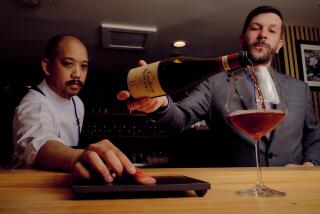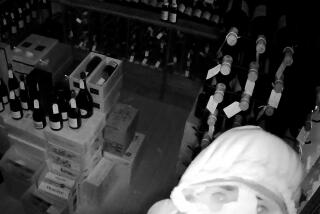Microsoft Wine Disc Is a Click
One of the joys of wine, besides drinking it, is reading about it, glass perched nearby, discovering the myriad places in which the grapes grow, the personalities who make the wines, and the tastes they offer.
Pleasure reading on a computer screen is something else, however, and although about a half-dozen publishers have put wine lore on computer CD-ROMs, most have been fairly dull. Some of the problems have been the design of the software; other problems have been due to poorly written material.
Giant Microsoft Corp. has now released by far the best CD-ROM on wine, making the point that some types of wine writing are perfect for this format. In particular, a wine encyclopedia.
The mundanely named Microsoft Wine Guide (Microsoft Corp., $39.95) is an extraordinary tool for anyone interested in wine, since it answers all the questions anyone could have and provides an interface so easy to use that no instructions are necessary.
*
As with any wine book, accuracy is essential, and to date the leader in this field has been Hugh Johnson. His “Modern Encyclopedia of Wine” remains the best instrument yet devised for learning about the varied world of the grape.
Add to that short list the name Oz Clarke, a former actor who now has a British television show on wine, as well as author of nearly a dozen wine books including an encyclopedia that is the basis for this CD-ROM.
The book has much to recommend it. The CD-ROM adds to it: Microsoft’s trenchant CD-ROM design integrates sound, video, color pictures, and an easy-to-use global search capability that makes finding out about wine, wine people, and other facts as easy as clicking.
After loading the disc into your drive (minimum recommended is four megabytes of RAM space, two megabytes on the hard drive and Windows; a Macintosh version is also available), up comes a screen of options including an index and a number of sound icons. Click on one; Clarke, ever the actor, is seen and heard in video clips explaining what’s on the page.
*
Try, for example, clicking on the sound icon on the New Zealand Sauvignon Blanc page. Clarke expressively says New Zealand has, in a short period of time, become the world leader in Sauvignon Blanc because it makes “wonderfully aggressive . . . love ‘em or hate ‘em wines, with aromas of asparagus, gooseberries, canned peas, cut grass, apple and lemon/lime.”
Search for details of the world’s great rose wines and you get, among other pages, this one:
“Rose des Riceys AC.
“Best Producers: Alexandre Bonnet, Morel
“Appellation: Rose des Riceys AC
“From: Champagne, France
“Grapes: Pinot Noir
“Tasting Notes: This is a curiosity and an expensive one at that. It is a still, dark pink wine made from Pinot Noir grapes in the southern part of the Champagne region. Improves with cellaring, up to ten years.”
Best Years: 1990, ‘89, ‘88, ‘85, ‘82”
At the top of the page is a sound icon; click it the name (roh-zay day ree-say) is pronounced.
Looking through the Loire Valley, at Pouilly-Fume, you get this:
“Didier Dagueneau
“Pouilly-Fume AC, Loire Valley, France
“The wild man of Pouilly-Fume, a much-needed innovator and quality fanatic in a complacent region. Best-known for his barrel-fermented Sauvignon Blanc called Silex. Drink young or with short aging when from best years. Best years: 1992, ‘90, ‘89, ’88. Price range: Expensive.” A color reproduction of the Silex label accompanies the text, which may be printed or downloaded to a personal list.
*
One wonderful section permits the reader (viewer?) to enter the sort of food you’re going to have and search the database for specific wine suggestions. Occasionally the number of suggestions is far too extensive to be practical, but at least they are, in my view, all correct.
Microsoft’s expertise in software design is evident in many places: Maps of wine regions show major roads, and you can widen or narrow the area being researched. Also, all data highlighted in yellow (as you might do in a book with a highlighter) are “hot”--just click on them and you get more detailed information. A “back” icon takes you to the previous page.
At any time, you can ask the disc to search for a word or phrase, which is better and faster than an index in a book.
This CD-ROM sets a new standard for wine on disc, one I hope others adopt. I can’t say if the screen will ever replace the book, but the functionality here is astounding. Just don’t spill your wine on the keyboard as you read.
Another new wine book is “Grands Vins,” subtitled “The Finest Chateaux of Bordeaux and Their Wines,” by Clive Coates (UC Press: $45; 816 pages). Never has there been as complete a book on the wine world’s most famous red wine region, and never have there been so many solid tasting notes on so many wines.
*
More than 100 chateaux are profiled, with marvelous insights into their owners, structure and wines. Tasting notes are extensive.
There are minor drawbacks here, but the writing is crisp and Coates, a Master of Wine and longtime publisher of a private newsletter in England called The Vine, is as knowledgeable about Bordeaux as anyone who ever lived. This is an exceptional work that any collector should have.
I can’t be as enthusiastic about “Dreamers of the Valley of Plenty,” subtitled “A Portrait of the Napa Valley” (Scribner: $25; 319 pages). That’s because I felt the subtitle should probably have been “Portrait of Cheryll Aimee Barron.”
Barron, who admits often in this rambling, diffuse work that she is a wine novice, spent much time interviewing interesting people, but then drawing some rather bizarre and inaccurate conclusions about this country’s best-known wine region.
For example, she theorizes that the French taught California how to make wine, demeaning the Italian heritage that is the very heart of California’s wine industry.
*
There are some very nice, elegantly written sections, especially profiles of people famous and obscure, woven into the text. But it’s so solipsistic and occasionally naive that it’s unnerving.
Two new guidebooks are both worth a look-see for those touring or armchair traveling. If you’re actually going to Napa or Sonoma you should have both books.
I really like the second edition of “The Napa and Sonoma Book” (Tim Fish and Peg Melnik, Berkshire House: $16.95; 325 pages). This is a great read as well as an excellent Baedeker to California’s most-toured wine regions. Unlike so many books before it, it isn’t cliched.
After a brief history of the area, the book explores every detail of touring, such as how to get to wine country from airports, where to roost and dine (with restaurant reviews), details of the shopping and culture, hundreds of phone numbers and lots of other details.
Alas, many wineries are left out, maps are pretty rudimentary and there are few specific touring ideas.
A bit more detailed, with slightly better maps, is “The Wine Spectator’s Wine Country Guide to California” (M. Shanken Communications: $6.95; 128 pages).
*
This 1995 version of an annual, magazine-format publication has more wineries (some 500) from all over the state; restaurant and lodging listings, and even sections calls Diversions, in which local events are listed.
Introductions to the various regions are well-written and a nice preview for those who have never toured there before.
Wine of the Week
1994 Heitz Cellar Grignolino Rose ($7.50)-- When hot weather sets in, dry pink wine is my wine of choice. Not only does it work with a wide variety of foods, it usually has the delicacy that Chardonnay lacks, so it’s thirst-quenching.
This wine is one of the world champions for quaffing, and it came about almost by accident. In 1961, Joe and Alice Heitz bought Leon Brendel’s Only One Winery, which made only one wine, Grignolino, from an otherwise obscure Italian grape that was growing on the ranch east of the Silverado Trail and south of St. Helena.
Heitz soon was specializing in powerful Cabernet Sauvignons, but he continued to make wine from the eight acres of Grignolino. In fact, he made three wines: a red table wine, a red dessert wine, and this orange/pale pink wine that has virtually no sugar, unlike the insipid sweetish roses of hotter regions.
I have always loved Heitz’s Grignolino Rose, and the 1994 is brilliant, scented with faint orange peel and blossom notes and an indescribable spicy aroma not unlike ripe melon rind. Fewer than 900 cases were produced in 1994, so only those who act quickly will get some. (Be warned: Some merchants won’t carry any rose, so you may have to order it.)
More to Read
Eat your way across L.A.
Get our weekly Tasting Notes newsletter for reviews, news and more.
You may occasionally receive promotional content from the Los Angeles Times.










